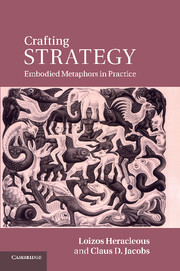Book contents
1 - Strategizing out of the box
Published online by Cambridge University Press: 05 June 2011
Summary
Strategy is regarded as serious business. The very origin of the term “strategy,” as the task of ancient Greek army generals, or strategoi (leaders of the army), underlies a view of strategy as rational, analytical, objective and top-down, involving extensive analysis and planning. Further, it privileges a top-down view of strategy as positioning in the battlefield, rather than organizing internally to deliver the competencies needed to effectively deliver a strategy. This emphasis on left-brain type activities and ways of thinking, as well as external positioning rather than internal organization, has hindered the development and widespread adoption of right-brain, creative, emergent ways of strategizing. These ways are more relevant to a processual, practice-oriented view of organizations, and an emphasis on actors, rather than a more static, industrial organization-inspired view of organizations concerned with external positioning. This book, based on our research and engagement with strategizing processes over the last decade, is an effort to redress the balance.
We begin this chapter by suggesting that to develop and sustain competitive advantage, strategists need to engage in practices that help them see things anew; to move beyond rationalist, analytical and convergent thinking and to engage in creative, synthetic and divergent thinking, through processes such as the playful crafting of embodied metaphors. Such a strategizing process differs markedly from conventional, analytical strategizing processes, and we employ the key stages of design thinking to highlight these differences. We finally outline the process of crafting embodied metaphors as a playful practice.
Information
- Type
- Chapter
- Information
- Crafting StrategyEmbodied Metaphors in Practice, pp. 4 - 16Publisher: Cambridge University PressPrint publication year: 2011
